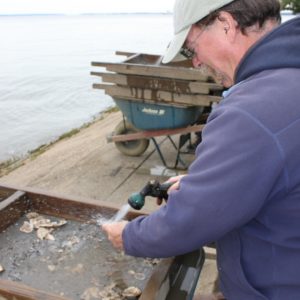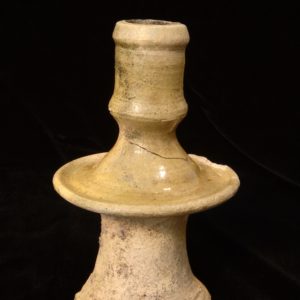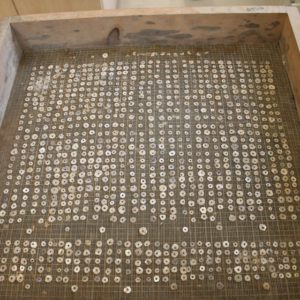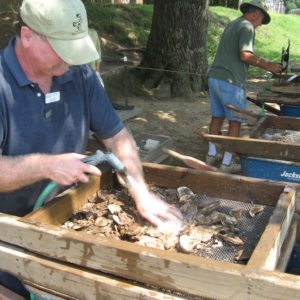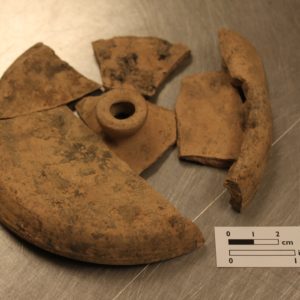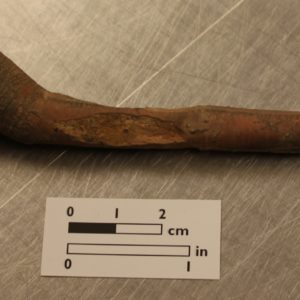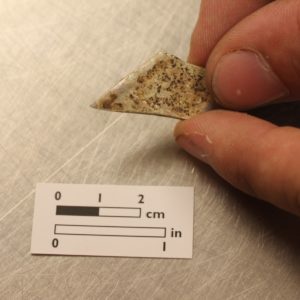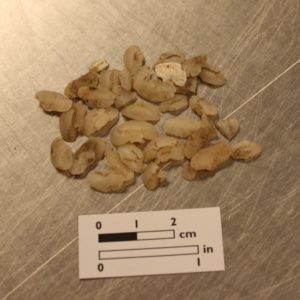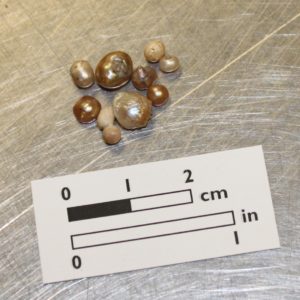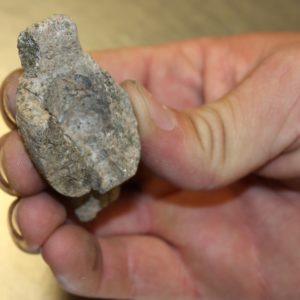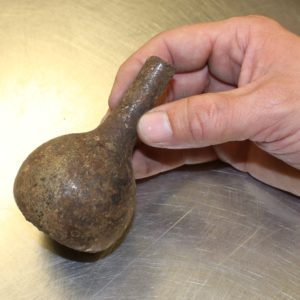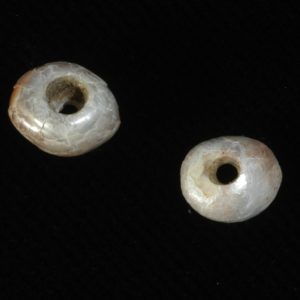The Jamestown Rediscovery archaeological team has hit moist soil about 9 and 1/2 feet deep into an early 17th-century well. The well is located very close to the center of the fort and archaeological evidence suggests that it is the fort’s first, built in 1609 under the direction of Captain John Smith. An exploratory probe of the soil hit the well’s wooden lining 11 feet into the pit and archaeologists are putting the finishing touches on a casing that will enable them to dig deeper while being protected from the earthen walls around them. Over the last few days more than 1500 shell beads have been found in the well. A nearly complete Virginia Indian pipe bearing intricate rouletting, a glass receiver, a Border ware candlestick, and several dozen fish otoliths were also found. The Smithsonian Institution is conducting a series of non-destructive tests on the slate tablet found in the well in May. These tests are designed to bring out the faintest details of the tablet’s inscriptions and catch things missed by the naked eye.
The well excavations are becoming more exciting with the discovery of wet soil about 9 and 1/2 feet below the surface. The anaerobic conditions below the water table allow for the survival of artifacts that would have disintegrated long ago had they been exposed to the varying wet and dry conditions above. Organic objects such as leather, wood, and even seeds have been found during the excavation of previous wells. Additionally, metal objects that would rust beyond recognition in the dry soil look much as they did the day they entered the well 400 years ago. Excavations of an early 1610s well in 2006 led to the discovery of a Scottish pistol and a halberd which were largely devoid of rust. Any artifacts excavated from such conditions need to be quickly immersed in water again to prevent deterioration. A probing of the wet soil hit the well’s wood lining 11 feet into the pit and there is some speculation that the actual shaft itself is square in shape like the one excavated in 2006.
Last month it was thousands of oyster shells being found in the well; this month it is shell beads. Over 1500 have been found in the well so far and this may be further evidence of Virginia Indians working inside the fort’s walls. Several pearls have also been discovered. An intricately rouletted Native clay pipe was recently found in the well. The pipe is nearly intact and its bowl bears a finely-dotted decorative pattern. Another Virginia Indian pipe made of steatite and consisting of a bowl only was found recently as well. It is likely that the smoker would have inserted a reed into the bowl to inhale its contents.
Several fish otoliths have been excavated form the well. Otoliths are structures found inside a fish’s head that are composed primarily of calcium carbonate. They are sensitive to acceleration and aid in motion and orientation. Calcium carbonate layers are added to the otoliths as they grow and scientists can tell much about a fish’s age and environment by examining them. As these layers are added, trace elements of the chemicals in the water where the fish live are trapped inside. Analyzing this chemical makeup can tell us much about the environment in which the fish lived 400 years ago. Though the amount of oyster shells being found in the well has tapered off, they are still being found, as are pearls.
A piece of cullet, the outer waste segment of a round of crown glass, was recently excavated from the well. A segment of a Border ware candlestick as well as an unglazed Border ware lid have also been found. Border ware often has a yellow-green glaze and was manufactured in the border regions of Hampshire and Surrey Counties in England. A nearly-intact glass object known as a receiver, which is used in distillation processes, was found in the well.
The slate tablet found in May covered in sketches and lettering is in the process of undergoing a variety of non-destructive enhanced photography tests. The Smithsonian Institution is using its computers and digital cameras to take high resolution photographs using different light sources and focal lengths to flesh out the tiniest details of the slate’s inscriptions. Another test, using x-ray fluorescence, will be used to examine the chemical makeup of the slate to compare it to known contemporary sources of slate in Europe. This will hopefully lead us to the source of the slate itself.
related images
- Archaeologist Dan Smith screens for artifacts in the dirt excavated from the well
- Newly-discovered base of a Border ware candlestick (right) compared to a more complete example found earlier
- Border ware candlestick holder found in the Blacksmith Shop/Bakery
- Some of the over 1,500 shell beads found in the well so far
- Dan Smith water screening oyster shell layer
- Oyster shells from well drying on the seawall
- Archaeologists Dan Smith and Danny Schmidt map part of the well using a transit
- Border ware lid
- Virginia Indian pipe with rouletting on its bowl
- Glass cullet
- Fish otoliths found in the well
- Freshwater pearls
- Virginia Indian pipe made from steatite
- Glass receiver
- Pearl beads



